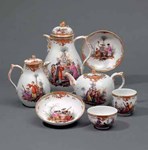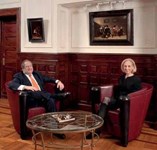Local tradition
SPEAK to almost any dealer and they say that the biggest change since TEFAF Maastricht was launched in 1988 is the multi-national nature of the fair, writes Alex Capon.
This is something that has accelerated over the last decade as the fair has reflected the general trend toward globalisation at the top end of the art market. Today, dealers come from 21 countries aiming to sell to visitors who fly in from all over the world to the small city for one week a year.
But, go back 40 years, and fairs in Maastricht were much smaller and notably more ‘Dutch’ affairs, including the two original precursors to TEFAF – the Antiqua and Pictura fairs. These events eventually merged in 1985 and morphed into TEFAF three years later.
That is not to say that these were unsuccessful – far from it – and TEFAF duly took on the key aspects of these events. And, despite the expansion in both the market and the fair’s format, some of these particularly Dutch features remain at its heart.
Naturally, the presence of a core group of dealers from The Netherlands has always been an important part of the fair. While 37 exhibitors at this year’s fair are on home turf, a number of leading Dutch dealers are also now based overseas, returning to show at the fair each year.
National pride
In terms of the domestic dealers, one exhibitor who knows a thing or two about the ‘Dutchness’ of the fair is Robert Aronson of Amsterdam’s Aronson Antiquairs.
A fifth-generation gallery owner specialising in Delftware, he has manned the family stand at every edition of TEFAF and stood at the Antiqua fair before that since 1982.
“I personally feel very proud of the fair,” he told ATG. “Today’s TEFAF grew out of two Dutch fairs and it became, and remains, the world’s top fair. It’s a real testimony to the Dutch vision of the dealers a generation before us. The mentality of dealers here is inherited from the earlier generation. It’s still there – an enlivened sense of tradesmanship that is typically Dutch.”
Mari Bies, owner of Eindhoven family gallery Kunsthandel Bies, is another longstanding TEFAF exhibitor who feels a sense of national pride in hosting such a major fair: “We are a small country but have always been strong in two things – we have great painters and great traders. For the last five centuries we travelled all over the world to buy and to sell – including the Far East.”
In his 30 years of exhibiting at TEFAF, Bies estimated that he has sold Dutch works to buyers from over 25 countries. “Every year we meet new people from countries you don’t expect; last year we sold a number of pictures to China, for example.”
When it comes to Dutch Old Masters, Bies believes that if you have a great ‘Golden Age’ picture Maastricht remains the best place to sell it. “The original source of the Pictura fair was Dutch Old Masters and from that base TEFAF developed into a broader fair,” he said.
“All the big dealers in Dutch paintings from London, Paris and New York will be here, so the fair remains the biggest showcase for Dutch art history.”
Among the dealers who specialise in Dutch works but are based overseas is Lawrence Steigrad. He opened a gallery in New York with his wife and business partner Peggy Stone in 1989 and together they have stood at TEFAF Maastricht since 2006 (see box left).
Steigrad, who is the son (and grandson) of Dutch collectors, said the market for Dutch pictures at TEFAF is underpinned by a basic market truth: “Collectors want goodquality pictures in good condition, and they are confident that that is what they will see at TEFAF Maastricht. The expectation is that reputable dealers will offer them fine art, backed up by the proper research and solid provenance.”
According to Aronson, what’s true of Dutch paintings is also true of Dutch ceramics. He estimates that at TEFAF around 15-20% of his sales are to Dutch buyers but the rest are international, especially north-west Europe (Germany and France) and also the east coast of the US.
Another Dutch expat, the London-based Oriental art specialist Ben Janssens, also said the bulk of his sales at TEFAF were to overseas buyers.
However, he also noted an important effect that the Maastricht fair has in terms of encouraging domestic buyers to enter the market.
“The fair obviously has lot of Dutch visitors,” he said, “but every year certain people become interested in the art and antiques directly thanks to their experience at Maastricht.
They then become drawn into the market because of the fair.”
This seems to reflect a theme shared by most long-time Dutch exhibitors – that the event acts like a centre of gravity, pulling in different objects and people into its annual obit. Bies says: “Maastricht is not a very big city so why do all these people make the trip? It’s one reason – there’s so much quality on offer.”
However, even if the direction of travel is ever more international, dealers still speak of “the distinctive Dutch feel” that TEFAF retains, something Steigrad said was “noticeable from the food to the interior”. When you find yourself munching on a kroketten on impeccably designed stand, you’ll know exactly what he means.









